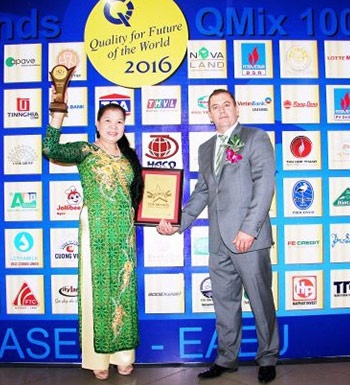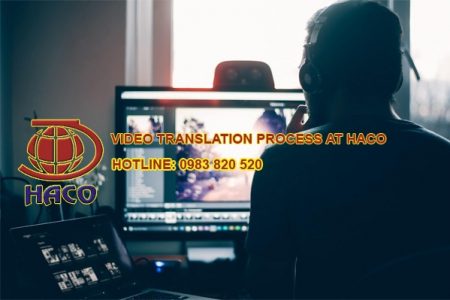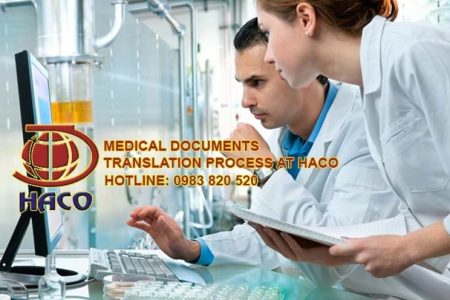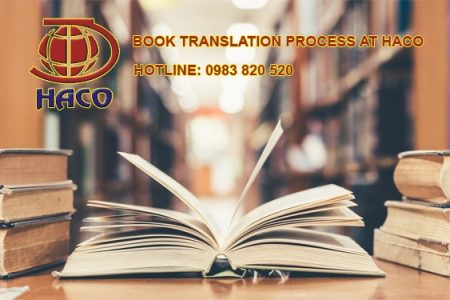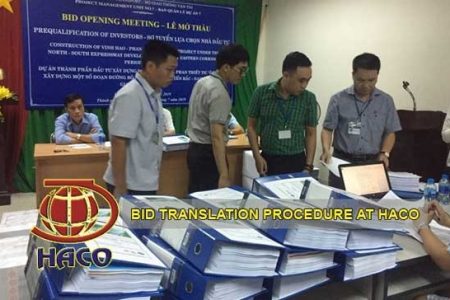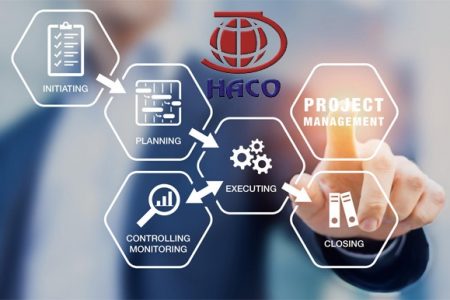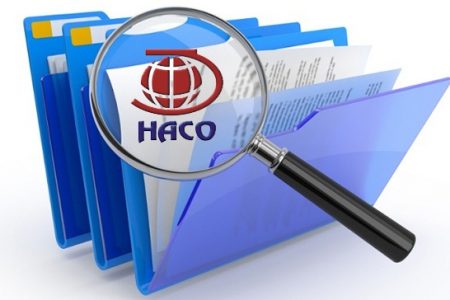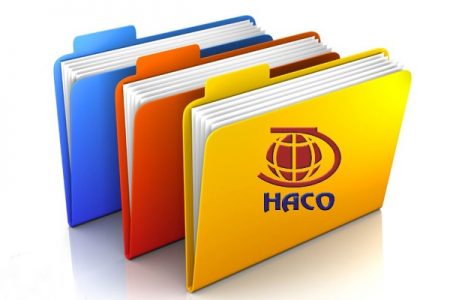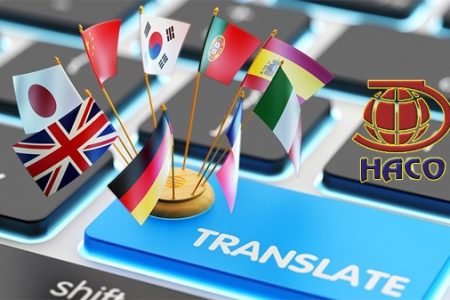Step 1: Analyze the project:
Divide chapter, determine the specialization as well as the difficulty level of documents.
Step 2: Select project personnel
This stage is especially important. It’s choosing the translator suitable for the project specialty. Project leader or expert determine up to 80% of the success of the translation project.
Step 3: Make a wordlist – sending to all project translators
To ensure the consistency of specialized words or repeated words and phrases.
Step 4: Translate
All translators are connected smoothly: network connection, phone, online, skype... during the translation process to create consistency in the translated content. Ensure optimal translation quality and complete translation progress in the shortest time.
Step 5: Proofreading
This is an indispensable step, which aims to unify the terminology, the translation quality in the most perfect way.
This depends on the expertise and accuracy of the Project Manager or the document editor.
Step 6: Formatting
To create the professionalism of the translated document, it must be the same structure as the original document.
Step 7: Review the project - To avoid mistakes in the process - Formatting documents.
The Project Manager and the Expert have the final control over both the content and the form before delivering it to the customer.
Step 8: Document Security
After handing over the translated document to the customer, main project leader is the person who keeps the documents in the server which is set password and it will be completely deleted within 10 days (if requested by the customer).
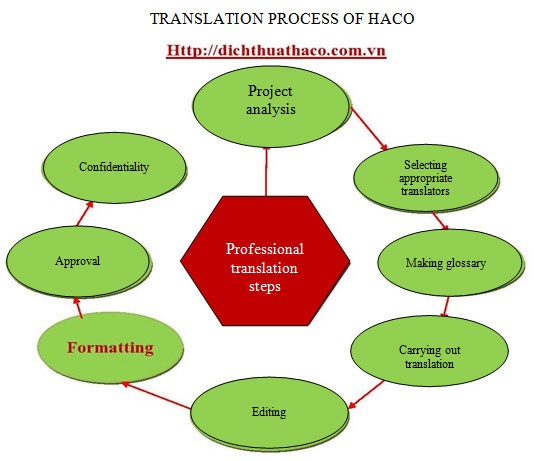
QUALITY MANAGEMENT SYSTEM
To implement the slogan "Conquer the pinnacle of quality", HACO Translation has a strict quality management system.
Specialized Employee: In addition to the necessary specialized foreign language skills, the translators and collaborators of the Company must have a second expertise, and can only translate documents in their expertise field.
Specialized documents/dictionaries: The company has a full range of dictionaries, documents and books in all fields of science, economics, medicine, construction, law, politics... which plays an important role in improving specialized knowledge for employees, helping them to translate in diverse fields. The Company's specialized dictionaries and documents are constantly updated, ensuring to provide Translators and collaborators with necessary tools in all fields, to achieve the highest quality for translation.
Advanced technology: In addition to the human factor, HACO also makes full use of the most advanced modern technology such as language software, specialized software, translation support software, online dictionaries, server system which help to improve data transmission speed, along with modern office equipment to help translators and quality controller to work efficiently and with the highest quality.
Strict management process: The head of the translation department is responsible for translation products: reviewing the content, ensuring the accuracy of the translation as well as the presentation of the document, then stamping it for Company’s confirmation.
SECURITY POLICY
HACO Translation has a good security system to ensure that customer documents are not disclosed. Requirements that collaborators and employees both need to comply with are as below:
- Do not contact directly/indirectly with agencies/individuals related to translation documents/projects;
- Do not disclose any information in the translated document;
- Upon completion, all documents (originals and translations) must be transferred to the company;
- Within 7 days after transferring documents to the Company, all data on the computer (or draft) must be deleted/destroyed if no other correction is required.
- If documents are overdue for 1 week because of collaborator’s fault, these documents will be unrecognized;
- In the field of finance and accounting, ensure the payment and settlement of contracts in accordance with the regulations of the corporate financial system.
TRANSLATION PROCEDURES VIDEO (TEXT TYPE)
Step 1: Video project analysis
- Classify video by type, difficulty level, subtitles available or not available.
Step 2: Select personnel.
- Through the analysis step, the appropriate personnel will be selected as well as the number of personnel participating in the project.
Step 3: Project implementation
- Video transcription – All the content spoken in the video will be re-typed in the original language (English). In addition, the words that appear on the screen are often called on-screen text or text popup, if any and need to be translated, they will also be retyped – The finished product of this step is called Script English.
- Timing English script into subtitle file: Use software tools to make subtitles (eg Aegisub) to set timecode or timing for English script created in item 1, the finished product of this step is English subtitle in text format, most commonly in the srt file format.
- Translating the English subtitle file into Vietnamese: This is the most important step, besides the existing English script, the translator still need to compare it with the original video to understand the context of the character for the most accurate translation. The completed product of this step is a Vietnamese subtitle file in text format in accordance with the format of the original English subtitles.
Step 4: Edit and approve subtitles
- The translator will have to check, modify and re-edit the translation to make it concise and accurate with original content.
- Project manager review and approve before sending to customers.
Step 5: Sending translation to customer.
Step 6: If the customer asks to amend from a professional perspective, Project Manager will review and adjust accordingly.
VIDEO (LISTENING TYPE) TRANSLATION PROCEDURES - INSERT SUBTITLES – RECORD VOICE
Step 1: Video project analysis
Classify videos by type, assess difficulty level, there are 2 types:
- Video only speaking without subtitles _ Voice is easy or difficult to hear _ Speaking fast or slowly
- Video with subtitles _ which have 2 types:
- Subtitles with voiceover
- For example: English voice but subtitles are in another language like German, but require translation into Vietnamese, then it can be translated from English voice, or from German subtitles.
Step 2: Personnel selection
Through the analysis step, the appropriate personnel will be selected as well as the number of personnel participating in the project. There are different types of personnel involved:
- Expert in listening and direct translation (interpreting), to write text accurately and in localized language.
- Expert in reading _ narration _ presentation, national standard voice. Male or Female voice at the request of the customer.
- The technical department ensures the voiceover recording and video completion.
- Professional subtitle insertion department with English, Chinese, Japanese, Korean,..
Step 3: Project conducting
- For only speaking videos:
- Must listen to translate (interpret) _ Experts listen to translate directly _ accurately record the translated text; Localize language. The Project Manager approves the content.
- Experts read _ present _ voiceover _ National standard voice (Male or Female voice depending on customer requirements)
- Technical department directs Voiceover recording and video finishing.
- For subtitled videos.
- Video transcription – All the content spoken in the video will be re-typed in the original language (English or other languages). In addition, the words that appear on the screen are often called on-screen text or text popup, if any and need to be translated, they will also be retyped – The finished product of this step is called Script English.
- Timing English script into subtitle file: Use software tools to make subtitles (eg Aegisub) to set timecode or timing for English script created in item 1, the finished product of this step is English subtitle in text format, most commonly in the srt file format.
- Translating the English (or other language) subtitle file into Vietnamese: This is the most important step, besides the existing English (or other language) script, the translator still need to compare it with the original video to understand the context of the character for the most accurate translation. The completed product of this step is a Vietnamese subtitle file in text format in accordance with the format of the original English subtitles.
- Edit and approve subtitles:
- The translator will have to check, modify and re-edit the translation to make it concise and accurate with original content.
- Project manager review and approve before sending to customers.
- Professional recording and voiceover
- Professional Subtitle inserting.
Step 5: Sending translation to customer.
Step 6: If the customer asks to amend from a professional perspective, Project Manager will review and adjust accordingly.
VIETNAM TOURISM & TRAINING - TRANSLATION JSC
PROJECT MANAGER

